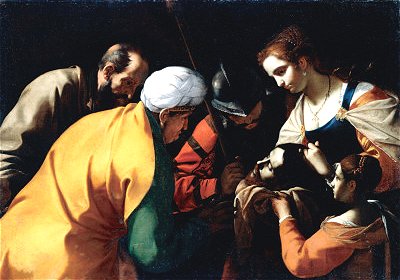 |
|
HERODIAS WITH THE HEAD OF JOHN THE BAPTIST
Mattia Preti Italian
1613-1699
SN 990 Oil on Canvas c. 1648
by Robert Anderson
ARTIST
Mattia Preti, known as "Il Cavalier Calabrese" after being
knighted by Pope Urban VIII, was one of the great painters of the Italian Baroque. His
early training was given him by his brother Gregorio. He travelled a good deal being
documented in Rome, Naples and Malta where he lived out his final years. During his
travels he assimilated a broad array of influences of which Caravaggio was preeminent.The
work of Caravaggio was probably learned third hand from pictures by Caravaggio's followers
Bartolomeo Manfredi and Simon Vouet. |
Preti's early work includes groups of musicians and
card-players but he later excelled mainly in frescos on religious subjects. By 1650 he had
become one of the most distinctive and evocative interpretors of Counter Reformation
spirituality and had reconciled his early eclectic origins into a highly personal style in
which Venetian Renaissance grandeur was transformed by the immediacy of Caravaggesque
realism and the emotional rhetoric of Guercino and Manfranco.
He had great success in Naples after the plague carried off virtually a
whole generation of the artists of that city. Preti attracted the patronage of the Knights
of Malta while in Naples and a number of paintings were done for churches on that island.
SUBJECT
John the Baptist was the son of Elizabeth, the cousin of Mary, twho was
the mother of Jesus. He had appeared as a herald preaching the coming of the "Kingdom
of God", repentence and the need of baptism for the forgiveness of sins. John had
testified to the coming of Jesus as the Messiah and had baptised Him in the river Jordan.
He was seen by some as a revolutionist.
Herod was the ruler of Gallilee who had married his brother's wife
Herodias in violation of Hebrew law. When John criticized this action he was thrown into
jail. At a birthday party for Herod, Herodias'daughter Salome danced so well that Herod
promised her anything she wished for. At Herodias' suggestion, Salome asked for the head
of John. Reluctantly Herod ordered the decapitation and John's head was brought to Salome
on a platter.
PAINTING
This painting is a fully mature example of the artist's work in the
manner of Caravaggio. Preti demonstrates that he has learned how to capture the essence of
the story with telling effect. He has dispensed with the supercharged drama found in many
paintings of Salome / Herodias, whose lurid story made the subject such a favorite with
Baroque painters. The significance of the Baptist's martyrdom is emphasized instead.
Depicted in this painting are Salome in a blue and gold dress holding
the salver; Herod a hunched figure with a craggy face wearing a turban; the executioner in
the red shirt and uniform of a soldier, and Herodias impassively holding John's head back
by the hair. The play of light and dark lends a greater presence to the nearly life size
figures who are shown close up, so that the scene appears to be taking place before the
viewer's very eyes.
HISTORICAL CONTEXT
This was time of great unrest in Israel. There were a number of
revolutionary movements against the government with a great emotional expectation of the
coming of a liberating Messiah. John the Baptist and indeed Jesus himself were looked upon
by the authorities and their upper class supporters as dangerous to the orderly exercise
of government.
|
